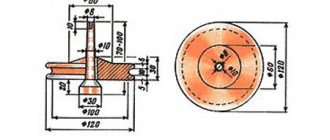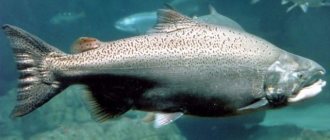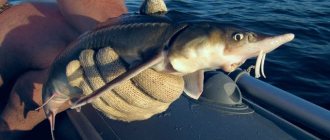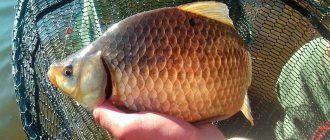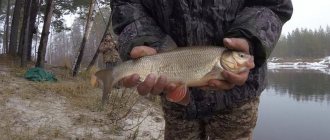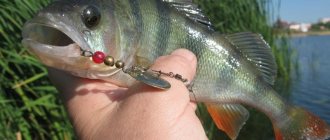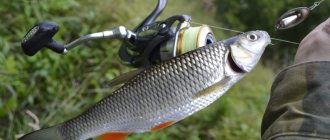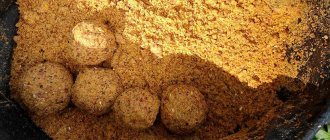Chinook salmon is a fish from the salmon family, the largest of the Pacific salmon. The most common weight of chinook salmon in catches is about 9 kg, with a length of 90-100 cm. In North America and Kamchatka, chinook salmon weighing 60 kg and up to 180 cm in length were caught. The scientific Latin name for chinook salmon is Oncorhynchus tshawytscha. The name comes from the Itelmen name “chovuich”. In North America, Chinook salmon is called by its Indian name - Chinook or king salmon, and the Japanese call Chinook salmon the Prince of Salmon. Chinook salmon is a migratory fish; it is born in the river, where it lives for some time, then goes to the sea to feed, where it actively feeds and reaches large sizes. When Chinook salmon reach sexual maturity, they sometimes travel thousands of kilometers to return to their native river to spawn. After spawning, Chinook salmon die. Chinook salmon is a valuable catch, and for many anglers, catching Chinook salmon is a lifelong dream. Chinook salmon is a valuable salmon fish with very tasty and healthy meat.
Appearance
Chinook salmon has a long, laterally compressed body. Chinook differs from other fish species in its size; anglers say that Chinook looks like a thick log.
Chinook salmon have a large head relative to the body, a large mouth, and small eyes. Chinook salmon are characterized by black gums on the lower jaw.
The color of Chinook salmon depends on its habitat. The back of the Chinook salmon can be light gray, greenish-silver, or olive. The sides are silver in color. The belly is light, even white. This color camouflages the Chinook salmon well in the water. The body of the Chinook salmon is covered with small, rounded scales.
Between the head and body there are large stripes. On the sides, above the lateral line, on the back, on the dorsal fin and both lobes of the caudal fin there are small round dark spots. Chinook salmon do not have the X-shaped spots and pink stripes along the body that are characteristic of other salmon.
Like other salmonids, Chinook salmon's appearance changes during spawning. The mating plumage of Chinook salmon is less pronounced than that of chum salmon or pink salmon. The body of the Chinook becomes brownish, with red spots, and the back and head area become darker.
Fishing in Kamchatka
Fishing location:
Bolshaya river, Ust-Bolsheretsky district
Fishing period:
from June 1 to July 15
Trophies:
Chinook salmon - average weight 6-15 kg (sometimes up to 30 kg)
By-catch:
Sima, Sockeye Salmon, Char, Kunja, Mikizha, Grayling
Fishing duration:
at the request of the fishermen
Recommended duration of fishing:
7 days
Number of fishermen in the group:
up to 19 people
Accommodation:
base "Big River", double rooms
Meals:
breakfast, lunch, dinner
Water transport:
motor boat made in the USA, Yamaha 40 engine, seats 3 people + guide
Tour cost:
calculated individually upon request (the cost of a day depends on the number of people in the group and the number of fishing days)
Approximate tour program:
Day 1 – arrival, meeting at the airport, organization of transfer “airport - base “Bolshaya Reka”, check-in at the fishing base “Bolshaya Reka” at 14:00, accommodation, lunch, departure for evening fishing, return to the base, dinner, bathhouse, rest. Days 2-7 - breakfast, departure to the river, fishing until lunch, return to base, lunch, departure for evening fishing, return to base, dinner, bathhouse, rest. Day 8 - breakfast, departure to the river, fishing until lunch, return to the base, lunch, departure from the Bolshaya Reka base at 13:00, organization of a transfer from the Bolshaya Reka base to the airport with a stop at the fish market.
Included in the price:
- accommodation in a double room at the Bolshaya Reka base - three meals a day (breakfast, lunch, dinner) at the Bolshaya Reka base - varied menu of freshly caught fish - staff services - boat rental with an experienced guide + fuel tank - lunch box in boat before and after lunch (sandwiches, tea, coffee) - voucher for catching Chinook salmon on a catch/release basis - sauna - transfer to the fishing base "Big River" and back - insurance
The price does not include:
— rental of gear — alcoholic beverages — processing and packaging of caught fish — tips for service personnel — other services not provided for by prior agreement
List of necessary things:
- warm clothes (average temperature in June - July 6-10 degrees) - waterproof suit, thermal underwear, fleece, waterproof shoes
Recommendations for fishing tackle for Chinook: spinning: spinning test 15-50 g, length 2.70 m cord 0.28 mm, cord length 130-150 m - baits: spinners No. 5, No. 6 wobblers with depth 2.5-3 .5 m color silver, bronze, gold, light green, yellow, orange, blue, violet
Fly fishing:
Two-handed rod 7-9 class. Set of sinking heads from S3 to S9
PS
Tips for service staff are not included in the price and are welcome
Area
Chinook salmon are Pacific salmon and are found along both the eastern and western shores of the Pacific Ocean.
Chinook salmon inhabit rivers along the entire coast of the American continent from Kotzebue Sound in Alaska to Southern California. Chinook salmon live in the Aleutian Islands, in the rivers of the Arctic coast of Canada to the Coppermine River. Chinook salmon are most abundant in the rivers of British Columbia (Canada), the rivers of Washington state (USA) and the Sacramento River (California).
In Russia, Chinook salmon live from the Anadyr River in the north to the Amur River in the south. Most Chinook salmon are found in Kamchatka, in the Bolshoy River and its tributaries. Chinook salmon lives on the Commander Islands, Sakhalin, and the Kuril Islands. In Japan, Chinook salmon live in the north of Hokkaido.
Recently, Chinook salmon have been bred artificially on special farms on the Great Lakes, in the USA, as well as in the rivers of New Zealand. About 40 years ago, Chinook salmon were introduced into the rivers of Patagonia and are now allowed to be caught in Chile and Argentina.
Chinook salmon habitats
In rivers, Chinook salmon prefers deep places with an uneven bottom and likes to stay close to various snags, which it uses as shelter. Often swims into river mouths, preferring places rich in underwater vegetation. Loves to frolic in fast currents. Although the Chinook salmon is a freshwater fish, it spends most of its life in the sea. Quite a few Chinook salmon stay close to rivers and in bays, but there is no pattern in this - other individuals swim far into the ocean.
Fishing places
What can you say about the present time? Chinook salmon have become incomparably smaller. Thus, in the Avacha River it has almost disappeared and can no longer be of interest to fishermen. The only accessible body of water for most local fishermen is the Bolshaya River, which is located on the western coast of Kamchatka in the Ust-Bolsheretsky region.
Wealthy amateur fishermen have the opportunity to catch Chinook salmon on the rivers of the western coast: Pymta, Vorovskaya, Kol. On the east coast, the Kamchatka River is notable. Vouchers are purchased from companies specializing in fishing tours in Kamchatka. Comprehensive information can be obtained via the Internet. For fishing on the Bolshaya River, paid licenses can be purchased at the parking lot at the mouth of the Nachilova River and at fishing bases in the village of Ust-Bolsheretsk, as well as in fishing shops in Petropavlovsk-Kamchatsky.
Read: Features of a multiplier kit for fishing with light baits
What does Chinook salmon eat?
Young Chinook salmon feed mainly on plankton, and as they grow older they switch to feeding on insects and their larvae, small crustaceans. Grown-up chinook salmon begin to feed on small fish and shrimp. Both young and adult Chinook salmon love to eat the eggs of other fish.
Adult Chinook salmon that move into the sea become dangerous not only for small fish, but even for medium-sized fish; Chinook salmon prey on herring and sardines. In the sea, chinook salmon feed on fish of various sizes, crustaceans, cephalopods, krill, shrimp, and squid. While at sea, Chinook salmon actively hunt and eat well, quickly increasing their mass.
Lifestyle
The life of Chinook salmon can be divided into three stages: birth and life in the river, migration and life in the sea, return to the river for spawning and death.
Chinook salmon fry are born in the upper reaches of rivers with fast currents. Once born, the fry gather in flocks, feed on insects and their larvae and grow quickly. Over time, they have to move from tributaries to larger rivers, going downstream, closer to the mouth of the river. The reason for this movement is the need for more food, which is not so abundant in the upper reaches of the tributaries. By moving downstream, young Chinook salmon are at greater risk of being eaten by predators.
You may be interested in: Shimano Reels: Top 10
Gradually, Chinook salmon switch to feeding on crustaceans and small fish. Young Chinook salmon stay in places with an uneven bottom, in sections of the river overgrown with underwater vegetation and in places with a lot of snags. Hiding in such shelters, they wait for suitable prey. Chinook salmon live in the fresh water of the river for 2-3 years, after which they move to the sea to feed. But not all Chinook go to the sea to feed; some of them remain in the river and represent a residential form.
At sea, Chinook lead a solitary lifestyle, living in the sea far from the shore. Chinook salmon can make very long journeys, swimming into the waters of the North Pacific Ocean, moving 3-4 thousand kilometers away from their native river where they were born.
In the sea, Chinook lead a predatory lifestyle, feeding on shrimp, crustaceans, fish, and cephalopods. Chinook salmon are actively feeding, growing in size, and gaining weight. In the sea, chinook salmon are hunted by beluga, killer whale and some pinnipeds.
Chinook salmon spend 1 to 8 years at sea until the time comes to return to their native river to spawn. Due to the large difference in feeding periods, there is such a large difference in the size and weight of the fish caught. In the same river, at the same time, you can catch a Chinook salmon weighing 1 kg and weighing 30 kg, and both fish will be the same age, it’s just that one of them spent only 1 year in the sea, and the other spent there 7-9 years. Previously, it was believed that the smallest males, the muzzles, did not go out to feed at all at sea, but later it was found that they stay in the sea for a very short time and do not leave the coastal zone, and therefore do not grow to serious sizes.
With the onset of puberty, the Chinook salmon begins its last life stage: returning to its native river, where it was once born, participating in spawning, for procreation, and subsequent death.
Chinook Fishing for Chinook in Kamchatka Lures spinners fishing for Chinook Caviar
Author: Nik | Date: June 25, 2014 | 372 | no comments
Chinook salmon is one of the unique fish of domestic waters. This is a very large representative of the salmon family. Chinook salmon live in the Pacific Ocean. Enters the rivers of Kamchatka, Chukotka and other northern rivers of the Russian Far East. It is in these rivers that Chinook salmon are caught! Moreover, unlike many popular fish - in quite sporting ways, using spinning rods. Of course, poaching methods are used by locals right and left, but we are interested in spinning fishing for Chinook salmon.
Chinook salmon can reach one and a half meters in length and weigh over 60 kg!!! Very large Pacific salmon!
External distinctive features of Chinook salmon: black spots on the upper fin and along the entire caudal fin. Small chinook salmon are very similar to coho salmon.
The period of movement of Chinook salmon in the rivers of Kamchatka is approximately from the end of May to July. At this time, they catch it in rivers, including with spinning tackle.
The places for catching Chinook salmon on the river during the course are very diverse. You can find a school on a powerful stream, and in holes, and, especially in areas below spits, islands, where several streams converge and return lines are formed, slowing down the flow, etc. Often, in deep water, you can find Chinook salmon in various branches of the river, oxbow lakes, creeks, without any current at all.
They usually move along the river in a boat in search of schools of Chinook salmon. They stop at interesting places and fish by wading, or from rocky spits or islands.
Polarized glasses are a must. They make it easier to track shallows, snags, and various subtleties of the bottom topography in small areas.
Considering that Chinook salmon is a powerful and large fish, you need to choose appropriate and strong tackle. Powerful spinning rod (better than the marine series). The action is medium, or better yet, parabolic, because The performance of the entire rod blank in the fight against large Pacific salmon is very important. The reel is a powerful multiplier, or a reliable inertia-free reel of at least 4000. A cord with a breaking force of at least 20 kg (more is possible). It is advisable to choose a cord with high abrasion resistance, because... the tackle will constantly be in contact with stones and snags. The fittings (swivel and American clasp) are correspondingly powerful. A swivel is needed if we fish with rotating spoons.
Now, about the baits that are used to catch Chinook salmon. Strictly speaking, any popular red fish that comes from the sea to rivers to spawn no longer feeds. So, the attack of artificial baits is an instinctive action, to drive away the irritant, some fish, small things (char, for example), encroaching on the offspring, caviar. In connection with the above, rather large oscillating spoons, heavy jigs, and persistent spinners No. 3-6 are used to catch Chinook salmon. Bright, pungent colors in the coloring of spinners are welcome!
In addition to the classic installation, they also use some kind of diverter leash. The weight bounces along the bottom, and above, through a wire outlet, a leash with a pinwheel is tied. This installation is good in places free from snags. So, we get fewer spoon hooks on stones.
In the rivers in question there are always a lot of hooks. There are a lot of snags, and there are also snags on the stones. You can assemble the tackle so that the cord unbends the tees. But, do not forget that with a little less success, but still, the hook can be straightened by trophy Chinook salmon. So, here, either there is a lot of loss of bait on the hooks, or very thoughtful fishing, on the verge, so that the hook does not unbend the salmon during the jerk.
In any case, you need to take a fair supply of spinners!!!
I do not recommend using wobblers. Fishing is often carried out in fairly shallow areas with a rocky bottom. It would be a pity to constantly break the blade of expensive wobblers on stones...
The Chinook bite is extremely sharp. Especially if you come across a specimen weighing more than 10 kg, the fight will be enchanting! What is noteworthy is that due to the fact that the fish only wants to drive away, kill the annoying little thing, and not eat it, the hooks rarely end up deep in the mouth of the Chinook salmon. You need to strike powerfully to cut through the hard edge of the mouth. All the same, there will be many gatherings - this is the norm. Considering the heroic hooks and the possible size of the trophy, the tackle must be really powerful.
In addition to the fish’s own strength, fishing has to be done in a strong current, which further complicates the process.
During the season, many fishermen from all over the former Soviet Union go to Kamchatka and other northern regions of the Far East to compete with strong Chinook salmon, admire the wildlife, and unwind.
But you must also be prepared for the dangers of wild places. Kamchatka, for example, has a huge population of bears. So, you need to have something with you to scare away the animal, for example: flares (animals are afraid of fire), or a signal pistol with flares (shoot not at the bear, but to the side, at the ground between you and the bear). You won’t be carrying around a gun all the time... A big knife, ala Rimbaud? Well, maybe just for self-soothing.
It’s good to start your acquaintance with fishing in Kamchatka from fishing bases. Local rangers will help you adapt to specific fishing, show you catch spots, and give instructions in case of extreme situations.
The weather during the Chinook run can also be extremely changeable and sometimes very harsh. Despite the end of spring, the beginning of summer, do not forget that this is the north! So, warm clothes, thermal underwear, waterproof overalls, waders - these are all necessary pieces of equipment.
A quality Gore-tex wading suit is essential. Most of the fishing time is spent wading. This makes it more convenient to cast the bait to the best points and reel in hooked fish.
“20 steps from a complete beginner to a confident beginner in FISHING”
It will be extremely useful for beginning fishermen. But not only that. I have collected the most important components of fishing skill and presented them clearly, systematically, “without water.”
Find out details
nik-fish.com
Reproduction
To participate in spawning, Chinook salmon travel thousands of kilometers to their native river, where they were once born.
Chinook salmon spawning is long in duration. In the Asian Chinook population, spawning begins in the last weeks of May or June and can last until August. In the American population, spawning also occurs in autumn and winter.
In order to get to the mouth of their native river, some Chinook need to swim only a few tens or hundreds of kilometers, others several thousand. Chinook salmon enter river mouths and form schools. The powerful structure allows Chinook salmon to swim against a strong current for many kilometers, overcoming a variety of obstacles, just to reach the place in the river where they once hatched.
When schools of Chinook salmon swim to spawn, it may seem that the entire river consists of one fish; when moving up the river, Chinook salmon often jump out of the water to overcome some obstacle. After entering the river to spawn, Chinook salmon stop feeding and only move up the river.
Schools of Chinook salmon are eagerly awaited by those who don’t mind eating this tasty and nutritious fish. The main enemy of Chinook salmon is the bear. Bears wait for schools of Chinook salmon, standing right in the river and deftly snatching the fish out of the water with their paws. This is the best time for bears; different types of salmon fish go to spawn one after another and the time of abundant feeding on fish lasts for several months. Otters also don’t mind eating tasty Chinook salmon. The otter cannot cope with the largest chinook salmon, but it is quite capable of coping with fish weighing a couple of kilograms. Small-sized Chinook salmon are also of interest to large birds of prey, such as the merganser. But the main enemy of Chinook salmon, which causes the greatest damage to its numbers, is man. Uncontrolled fishing of Chinook salmon going to spawn can lead to a significant decrease in the number of this tasty and healthy fish.
For spawning, Chinook salmon choose places in the river with a pebble bottom and large stones. Female Chinook salmon, having arrived at the spawning site, use their tails to knock out spawning holes, where they lay eggs. The female lays 10-15 thousand large eggs. Not all eggs laid will turn into fry, some of them will be carried away by the current and they will find themselves in unfavorable conditions, some will be eaten by other fish. Around each female there are 5-10 males, both large and very small mushers. Males of Chinook salmon who have reached sexual maturity without going to sea to feed are called munchers. At the age of 2-3 years, they have a length of only 10 to 50 cm, but at the same time they participate in spawning along with anadromous males. Once the female lays her eggs, the males fertilize her.
Spawning is over. Serious hormonal changes occur in the body of Chinook salmon; in addition, the fish expended too much energy during spawning. These two factors decide the future fate of the fish. Within two weeks after spawning, Chinook salmon that have fulfilled their parental duty die.
Chinook salmon fishing: where, how, what
In Kamchatka
Search for Chinook salmon habitat
You need to look for fish on the rifts and the holes washed out by the current located immediately on them. It lives in these places in the rivers, using its favorite hunting technique: it drives small fish swirling there out of the holes, driving them into shallow water, where it overtakes them. Since the skin on the belly of the Chinook salmon is dense, the Chinook salmon is not afraid to pursue prey while only half in the water.
Often small, 10-15 fish, schools of Chinook salmon can be seen near the washed-out bank of a small river, where they settle in the heat in the shade of trees and bushes and under the canopy of roots washed away by the river.
Fishing season
In principle, it occurs immediately after the opening of the rivers. More specifically, from about mid-May, with the beginning of the flood. But:
- the water is cloudy due to snow melting in the tundra and in the floodplains of small rivers and channels
- The “holders” of the plots, who at one time came to the rescue of Rosrybolovstvo and leased fishing plots for 40-50 years, now do not fuss and issue fishing licenses through a tree stump. It’s difficult to even catch them on the spot - apparently, when distributing bonuses, they grabbed something else, in other areas of activity, and now they are nimble there.
Something needs to be clarified here. There are barely a dozen truly convenient rivers for amateur licensed chinook fishing in Kamchatka (and this is out of about 14 thousand rivers!) Why? Yes, because according to some parameters, the Kamchatka Territory largely remains Terra Incognita - no human has really set foot there. And you need to see what it is: the floodplain of small channels of a large river. There is NOT ONE piece of land where you can put your foot! Alder, willow, shelomaynik, growing directly from the water's edge. Not a single dry area where you can walk freely. Well, perhaps with a continuously running chainsaw.
- If you are not familiar with local realities, book in advance the opportunity for licensed fishing on such catchy rivers as Kolpakovo, Kol and Pymta. And discuss this point with your tour operator in advance - with “iron” papers signed and stamped.
Essentially, the only rivers for unhindered Chinook fishing are the Kamchatka and Avacha on the east coast and the Bolshaya on the west. There are also quite a few deep-water ones, with banks convenient for casting gear from the shore, and navigable ones (for small motor boats, at least). But you can only get to them by helicopter. For those who don’t know, an hour of flight time costs about 200 thousand rubles. And it’s not an hour to fly there! Moreover, you will need to get out. And also - Kamchatka is not without reason called the land of bears, and the Kamchatka bear is a special type of bear, a direct relative of the American grizzly...
The mentioned Kamchatka, Avacha and Bolshaya are really big: they are navigable, and a fishing license can be bought right on the river, and everything is in order with the infrastructure there - there are access roads, places to stay, and the benefits of civilization in the form of shops. Just be prepared for a weekend of elbow grease (especially in the best fishing spots). And the price of boat rentals these days almost doubles.
Also make sure that you have an experienced (this is a must!) guide-excursion guide-expert in fishing. Who will show you the places and introduce you to the features of this section of the river.
And also be prepared for the fact that you are unlikely to come across a trophy specimen weighing at least 20 kg. Your destiny, most likely, will be catching the impassable form of chinook salmon. And these are 99.99% males weighing about 4-5 kg. Which, of course, is also not bad.
Tackle
If you are going to the same Bolshaya or Kamchatka, do not bother with top-end samples of wobblers and spinners for 30-50 USD. a piece. Especially when the spring flood has not yet subsided. Chinook salmon will ridicule you, use simpler equipment, the main thing in it is reliability and thoroughness. A rotating spoon with a good mirror surface on a steel leader, a sinker weighing about 40-50 g, a tee for cod and a line with a millimeter cross-section - this is what you will most often need. Twitch the spoon with sharp half-meter jerks against the current, and after a while you will feel a strong blow from the Chinook salmon on this tackle. Bringing the caught fish to the shore is entirely your responsibility and skill.
Spinner for Chinook salmon
When fishing on the river. Kolpakovo (not far from the fish processing base) or on the river. Largely, you can agree in advance with employees of fish processing enterprises about emergency freezing of caught Chinook salmon. If it freezes to minus forty, you have every chance of transporting it within three days to Moscow or Kyiv, taking into account a 9-hour non-stop flight.
What do they use to catch
In addition to spoons, you can catch fish with a wobbler or live bait when the flood ends and the water becomes clearer. The wobbler is selected depending on the depth and speed of the current; live bait is used for the tenacious and frisky juvenile char, 8-12 cm in size, that lives nearby. However, you still need to catch it, and prepare a cage to keep it.
Wobbler for Chinook
Alaska
Fishing Features
On the rivers of Alaska (which are smaller in number than in Kamchatka) there are much more places suitable for licensed fishing. Moreover, they are specially equipped, they have many household amenities - right down to connecting a residential trailer to the sewer pipe. Obtain a license on the spot, just try, if you happen to go fishing in Alaska, to strictly comply with American laws regarding fishing.
If one of the conditions is to release the caught fish back into the river, do it without hesitation! True, they will photograph your catch with you from all angles, and give you a certified certificate that you, such and such, caught a Chinook weighing so many pounds and length of such and such, on such and such a date and year. The weather conditions are like this. Time. Date of. Signature. Seal.
In the same place where you can take the caught prey with you, it will be frozen dry until glass shatters and even packed in a thermal container made of polystyrene foam or polystyrene foam to maintain a negative temperature for at least 3 days.
Selecting a base
Local residents value comfort most of all - therefore, this parameter of relaxation is taken into account by them the most. Extreme sports fans will most likely go to Russia. Comfortable fishing conditions include:
- The ability to quickly get to fishing spots from your place of residence, thus saving travel time
- Availability of infrastructure at the fishing site - a tent, house or place for setting up a trailer with the ability to connect water, electricity and other amenities
- The presence of a specialist at the fishing site who can give qualified advice.
- Possibility of leisure for other family members who are not directly involved in the fishing process.
Fishing methods
- Spinning. In this case, it is equivalent to using both gear rented on site and your own (many, by the way, will prefer renting, since real professionals in this field work at the fishing sites). They use oscillating spoons weighing up to 50 grams or rotating ones, with blades Nos. 5 and 6. Have a supply of baits and winding rings, they definitely won’t be superfluous! Reels (inertia-free or multiplier) must have a large supply of fishing line. Besides. you need to keep in mind the possibility of catching a trophy specimen weighing 10 kg or more on the spoon - which is quite capable of throwing a fisherman into the river with a sharp jerk. It is better to have a marine class spinning rod.
- Fly fishing. About the same as for coho salmon, just keep in mind the possibility of rapid changes in the water level in the river - a phenomenon that is not so rare in rivers fed by mountain glaciers. Then snags, pitfalls and other obstacles that interfere with fishing are almost exposed. The tackle is two-handed, with Skandi or Skagit cords or heads. In difficult conditions of rapids and slowing currents in pits, you need to keep in mind the possibility of forced fishing, so a volumetric reel with an effective braking device will also not be superfluous.
Fly fishing
Chinook salmon fishing
Chinook salmon has always been considered a valuable fishing object due to the valuable taste of its meat. According to fishermen, the most popular are Chinook salmon caught immediately after entering the river from the sea, even before the start of the ascent along the river to the spawning grounds.
You may be interested in: Toray Salt Line PE braided cord
Chinook salmon is considered a very cautious fish; it chooses places for its parking in the river in such a way as to ensure the maximum possible safety.
Due to active fishing, the size of the Chinook salmon population in Russia has greatly decreased. The main damage to the Chinook salmon population is caused by poachers, because of which Chinook salmon suffer more than other salmon fish, since they are the largest in size and come to spawn earlier than other fish. In many rivers of the Far East, Chinook salmon have either disappeared completely or there are very few of them left. Most of the Asian Chinook salmon population spawn in Kamchatka rivers. Industrial fishing of Chinook salmon in Kamchatka is prohibited, except as bycatch and only off the eastern coast.
For many fishermen, catching Chinook salmon is a lifelong dream. Chinook salmon are caught using spinning rods and fly fishing.
Chinook salmon that are caught vary greatly in size and weight. An angler can catch a fish weighing either 10 kilograms or 30 kilograms. This difference in size and weight is explained by the difference in the time the fish spent at sea. The more years a Chinook salmon has spent at sea, the larger it is. In Russia, Chinook salmon are most often caught in the rivers of Kamchatka, especially in the Bolshaya River, its tributaries.
To catch Chinook salmon, you should use a powerful rod with an upper test limit of 40-56 grams. A rod for catching Chinook salmon should be of medium action. When fishing from a boat, it is recommended to use a longer rod; when fishing from the shore, there is often no possibility for a full cast, so you can use a shorter rod.
The rod is equipped with a spinning reel of size 4000-5000 according to the Shimano classification. You can use multiplier reels. To catch Chinook salmon, it is better to use a braided line with a breaking load of 30-40 Lb.
To catch Chinook salmon, large salmon spinners weighing 32-56 grams, rotating spinners with blade numbers 5 and 6, weighing up to 30 grams, are used. Good results are shown by spinners of silver, golden colors and bright provocative colors. Recently, an increasing number of anglers have been using different types of wobblers when fishing for Chinook salmon.
Chinook salmon rising up the river to spawn do not feed from the moment they enter the river; they attack the bait not to eat it, but to protect their future offspring from other fish.
When fishing for Chinook salmon, there are a large number of bait hooks and breaks, so you need to take a large supply of spinners with you, at the rate of 6-8 spinners for one day of fishing.
Equipment for fishing for Chinook salmon requires waders with wading boots, or, in extreme cases, high waders. It is advisable that the fisherman be equipped with good membrane clothing, as in Kamchatka, even in summer, there are large temperature changes.
Tackle
To catch Chinook salmon, spinning rods 2.7-3.0 m long with a medium-fast action are used (with a soft spinning rod it is more difficult to penetrate the clawed mouth of this fish when hooking). The test should allow fishing with spinners weighing 15-50 g. For the “Kamchatka tackle”, a test of 40-200 g is required.
“Spinners” are used like Blue Fox No. 5-6, weight 18-50 g (depending on the current). On reaches with a calm current and in oxbow lakes, “shakers” and wobblers also work well. But they need to be re-equipped with more powerful tees and durable winding rings with swivels. For the “Kamchatka tackle”, “spinners” with light petals are used.
I am a supporter of the “Kamchatka tackle”, I will describe it in more detail. This equipment is usually used for fishing from a boat and is a design in which a rotating spoon (usually yellow or white) and a sinker on leads of different lengths are attached to a wire beam made of stainless steel wire with a diameter of 0.8-1.0 mm. The length of the “shoulders” of the rocker arm: 5-6 cm for a sinker, 9-10 cm for a spinner. This type of gear allows you to control the bottom movement of the bait. It is advisable to use spinners with a matte rather than glossy surface at the beginning and end of the season. Sinkers for the “Kamchatka tackle” need to be of different weights (70-150 g), so that when retrieving, the fisherman always (both in weak and strong currents) feels the sinker rolling, tapping on the bottom. This is very important when fishing for Chinook and Coho salmon.
Read: Methods of casting a spinning rod: understanding the nuances
The main line used is a monofilament line with a diameter of 0.8-1.0 mm; a cord can also be used (the bottom of Kamchatka rivers is rarely rocky). With a cord, careful bites are more noticeable, the hooking is much shorter than when using mono.
The spoon is tied to a leash up to 1 m long made of monofilament with a diameter of 0.7-0.9 mm; sinker - to a leash of the same diameter, but 20-30 cm shorter.
Cooking Chinook Salmon
Chinook salmon is considered a valuable salmon fish with tasty and healthy meat. The calorie content of Chinook salmon meat is estimated at 146 kcal per 100 grams of product. The calorie content of Chinook salmon can vary widely, depending on its habitat, age, gender, and time of fishing.
Chinook salmon meat contains vitamins: B1, B2, C, PP, K. The meat of this fish contains many useful minerals: zinc, selenium, calcium, potassium, phosphorus, iron, magnesium, molybdenum, sodium, nickel, chromium and fluorine. Chinook salmon meat contains up to 20 g of protein per 100 g of product. The percentage of fat in Chinook meat is very small and amounts to only 11-13.5%, which is slightly less in comparison with the meat of other salmon species. Chinook salmon meat contains choline and Omega-3 fatty acids, docosahexanoic acid (DHA) and eicosapentaenoic acid (EPA), which are very valuable for the human body.
When you include Chinook salmon meat in your regular diet, the body is saturated with many useful substances that improve its protective functions. Low calorie content and the presence of a large amount of easily digestible protein allow the meat of this fish to be included in the dietary menu. Chinook salmon meat has a rich red color with a crimson tint. Chinook meat tastes like salmon meat, but when cooked correctly it turns out even tastier.
Chinook salmon meat should be consumed with caution by pregnant women, nursing mothers and people with chronic problems with the gastrointestinal tract.
Chinook salmon caviar is prized. It is characterized by the presence of a bitter taste; individual eggs reach a size of up to 6-7 mm. Chinook caviar contains a large amount of vitamins and minerals beneficial to humans and has an excellent delicate taste.
You should not consume large amounts of Chinook salmon caviar (more than five teaspoons per day), due to its high sodium content, which can lead to disruptions in the functioning of the human body.
A wide variety of dishes can be prepared from Chinook salmon. Particularly appreciated are dishes prepared from lightly salted chinook salmon. Chinook salmon is salted according to a special recipe, after which it is suitable for preparing cold appetizers and salads. Chinook salmon meat can be marinated, smoked, and grilled.
In America, Chinook salmon meat is cooked over hot coals, which is considered a special delicacy. Chinook salmon is good when dried; balyk made from this fish is considered a special delicacy. Chinook salmon, salted with a large amount of salt, is soaked and then consumed as a snack and in salads.
You might be interested in: Jig
Lightly salted Chinook salmon
The most delicious dish of Chinook meat that you can prepare is lightly salted Chinook. When it comes to salt, Chinook salmon definitely has no equal. In order to preserve the bright and unique taste of chinook salmon as much as possible, it should be salted dry.
Defrost frozen chinook salmon for 10-12 hours, first in the refrigerator, then at room temperature. We start cutting the fish when it has not yet completely defrosted, then it will be easier to remove the bones.
We cut off the head and tail of the chinook salmon with a knife, and cut off the fins with scissors. We put these parts in a bag and put them in the freezer, later you can cook a wonderful fish soup from them. Remove the insides of the fish. We fillet the fish, remove the backbone and bones.
Prepare the mixture for salting. For every 1 kilogram of Chinook salmon, take 5 tablespoons of salt and 2 tablespoons of sugar. You can add crushed fennel seeds, ground black pepper, dill, and bay leaves to the mixture.
Skin-on Chinook salmon fillet is washed with water and dried with a paper towel. You can lubricate each piece of fish with strong alcohol (vodka, cognac or rum) and let it soak for 10-15 minutes. Alcohol will make the meat more tender, soft and enhance its taste, and it will not be felt in the finished fish.
We roll each piece of chinook salmon and rub it with the curing mixture on all sides and place it in a deep glass or enamel bowl, skin side down. Cover with a plate, press down and put in the refrigerator for 40 hours.
When the Chinook salmon is ready, shake off the salt and taste it. If the fish is too salty, rinse it with cold running water and let the water drain. Serve on the table.
Chinook salmon fried on charcoal
Chinook salmon fried on charcoal is one of the most delicious dishes that can be prepared from this tasty and healthy fish. You can fry both freshly caught chinook and frozen chinook on coals; of course, freshly caught chinook that has not been frozen turns out much tastier, but frozen chinook also turns out very well when grilled over charcoal.
Before the frying process, Chinook salmon must be pre-prepared. Frozen Chinook salmon must first be defrosted; to do this, defrost it for 10-12 hours, first in the refrigerator, then at room temperature. We start cutting the fish when it has not yet completely defrosted, then it will be easier to remove the bones.
We cut the chinook salmon into layers; to do this, use a long, sharp fillet knife to separate the left and right sides from the ridge. Then, carefully, cutting with the tip of a knife, separate the ribs. There is no need to clean off the scales. We cut the layer into separate pieces, each 6-8 cm wide. The fattest and most delicious pieces are located in the front part of the Chinook salmon. We marinate the resulting pieces; to do this, sprinkle each piece with salt, ground black pepper, various seasonings of your choice, and pour freshly squeezed lemon juice over each piece. Place the pieces of fish in a container with a tight-fitting lid and let stand for 2-3 hours.
While the chinook salmon is marinating, you need to light enough coals so that you can fry the fish on them. It is best to grill Chinook salmon on a grill rack that has a convenient lid and allows the fish to sear on both sides. At the very beginning of frying, you can add a little alder shavings or dust to the coals; the resulting thick smoke will give the fish a pleasant smoked aroma and taste. During the frying process, the grill grate with fish must be constantly turned over so that the fish does not burn. You need to carefully monitor the coals so that no open fire is formed, otherwise the fish will burn. To cook chinook salmon, 20-30 minutes are enough. If desired, at the end of cooking, you can also add alder shavings or dust to the coals to enhance the smoked aroma and taste. Chinook salmon cooked over coals can surprise the most demanding gourmet.
Chinook salmon baked on coals in foil
Chinook salmon baked on coals is a wonderful, very tasty and healthy dish. In order to bake chinook salmon, we cut it into layers, removing the backbone and ribs, using a sharp fillet knife. Cut into pieces 6-8 cm wide.
Place the prepared pieces of chinook salmon in a container with a tight-fitting lid, layer the layers of fish with onion cut into rings, slices of tomatoes and sweet peppers. Add salt, ground black pepper, crushed fennel seeds, dill, bay leaf and pour dry white wine. Leave in a cool place to marinate for 2-3 hours.
After the Chinook salmon has been marinated, take out a piece of fish, onion rings, tomato slices and pepper from the marinade and wrap it all in two layers of foil. We wrap the inner layer of foil very carefully, trying not to leave holes or cracks. We wrap the outer layer of foil so that there are small gaps between it and the inner layer of foil.
Place the pieces of fish wrapped in foil on the coals for baking. During the cooking process, pieces of fish wrapped in foil need to be turned over several times. After about 20 minutes, the chinook salmon baked on coals is ready.
